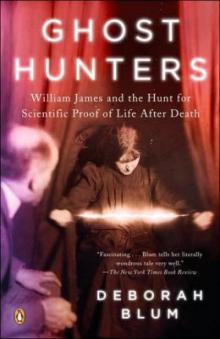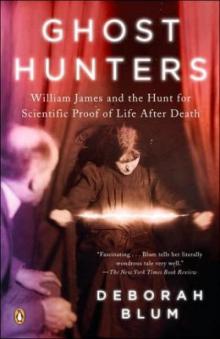- Home
- Deborah Blum
Angel Killer Page 2
Angel Killer Read online
Page 2
In fact, it was barely four weeks later that the landlady called King to say her former boarder had indeed come for the check. King grabbed a precinct squad car and hurtled across town. He found his man in the rooming-house parlor. King hesitated at the door. Surely this frail, grandfatherly man in his faded suit wasn’t the killer he’d been chasing all these years.
The detective stepped forward and the visitor stood up. The Gray Man put down his teacup and pulled a straight razor from his pocket.
Six
His given name was Hamilton Howard Fish, and he was born in Washington, D.C., on May 19, 1870. He liked to claim that he was related to another Hamilton Fish, the one who had been Secretary of State when he was born. But as a child, he’d started insisting on being called Albert, he said, because other children found the name Hamilton hilarious; he was sick of being called “Ham and Eggs” Fish.
His father, Randall Fish, was a former riverboat captain. At age 75, he’d already had three children by the time Albert was born. The elder Fish died five years later, leaving his widow, Ellen, struggling to support herself and their four children. And young Albert was a problem. He became a bed wetter; he occasionally ran away. At wit’s end, she placed him in Saint John’s Orphanage, a children’s home run by the Episcopal Church in the city’s Foggy Bottom neighborhood. “I was there ’til I was nearly nine,” Fish said once in a jailhouse interview. “And there’s where I got started wrong.”
The orphanage ran by the spare-the-rod-spoil-the-child rule. “We were unmercifully whipped,” Fish recalled. One teacher liked to add public humiliation to the corporal punishment, forcing the children to strip bare and stand before the class. With repetition, Fish found that he enjoyed the experience. The sting of the rod against his skin stimulated him. Watching the other children suffer aroused him sexually. There were days, looking back, when he blamed the orphanage for all his troubles, claiming it had “ruined his mind.” Or perhaps he had been somehow born wrong. “I always had a desire to inflict pain on others,” he explained to a psychiatrist who met with him after his arrest, “and to have others inflict pain on me.”
Instability did run in his family. A half-brother died in a lunatic asylum. So did an uncle, institutionalized for religious delusions. One of his younger brothers was diagnosed as feeble-minded, a 19-century term for people considered mentally deficient. Another brother was an alcoholic; a sister had a “mental affliction.” His mother suffered from hallucinations.
Despite her peculiarities, by the time Fish was nine, his mother had found a steady job and retrieved him from the orphanage. By then, however, he was a changed boy. He’d become a sexual voyeur and began spending his spare time visiting public baths so that he could watch other children undress. By his late teens, he’d started stalking children. He learned how to lure his victims with pocket change and candy. He learned how to take advantage of old buildings and dark alleys. “It never came out,” he told a psychiatrist. “Children don’t seem to tell.”
After he finished high school, Fish drifted through odd jobs. He traveled the country and pieced together a living, all the while hunting, sexually assaulting, and—when he was in the mood—killing children. By age 24, he’d settled in New York, where he found enough work to get by, mostly as a housepainter and handyman. He rented an apartment on Manhattan’s Upper West Side and moved his mother north from Washington to stay with him.
He married in 1898, and his time with his wife, Anna, marked the beginning of the most stable period of his life. They had six children together, and his sons and daughters swore that until 1917, the year their mother ran away with another man, their lives seemed normal enough. After Anna left, their father tried to hold the family together. He’d always struggled to hold onto jobs, but now he took whatever work came his way.
He also began to disappear more often into the city’s shadows. He quit trying to hide his obsessions. Once, he rolled himself in a carpet, insisting that John the Apostle had ordered him to do so. Other evenings he’d stand before his children, whipping himself with a board studded with nails, dancing with delight as the blood ran down his legs.
And there was that memorable night in 1922. They’d rented a bungalow, near the small town of Greenburgh in rural Westchester County, where Fish had been hired to paint the exterior of a church. He worked hard during the day, his sons helping him with the job. But at night, his children watched him run naked through the fields around the house, raising his fists and screaming, “I am Christ!” He was crazy, they thought, and getting crazier.
Still, they were as shocked as everyone else when, after King had subdued him in the boardinghouse parlor, Fish led police back to that same small town, to an isolated little house called Wisteria Cottage. Night had fallen by the time they arrived. The house sat amid a tangle of weeds and bare trees, illuminated by the glare of police lights. Fish walked straight to a crumbling stone wall that curved along the hillside behind the cottage. It took only minutes of digging to uncover Grace’s small, dirt-encrusted skull.
Later, police would find a startling collection of bone fragments in the basement of the house, leading newspapers to speculate that the bodies of dozens of children were buried there. Experts working with the police identified them as animal bones, but the question of how many children Fish had killed continued to bedevil the authorities. He confessed to stalking, torturing, and assaulting 400 children while traveling the country. But although he was a suspect in a long list of child killings—including nearly ten in the New York area alone—he turned silent and tearful when questioned about them. Hadn’t he done plenty already by telling them the story of Grace Budd? “You know as well as I,” Fish wrote from his cell in a letter to King, “that if I had not written that letter to Mrs. Budd I would not be in Jail. Had I not lead you to the spot no bones would have been found and I could only be tried for kidnapping. It was a fate to me for my wrongs.”
Seven
The words came to him more clearly now. He could hear the angel murmuring its promises if he only obeyed. Be happy, the voice told him. Happy is he that taketh thy little ones and dasheth their heads against the stones.
In mid-February 1935, Fredric Wertham, 39, a thin, bespectacled, German-born psychiatrist, sat down to talk with the Gray Man. Wertham had been hired by Albert Fish’s defense attorney, who planned to fight for his notorious client’s life with an insanity defense.
At the time, psychiatrists like Wertham who worked with the mentally ill, especially within the legal system, were still known as alienists—from the French word aliéné, “insane.” The etymology traced back further, to the Latin of the middle ages, alienare, “to deprive of reason.” The term held another meaning, however, beneath its scholarly surface. There was a sense that alienists studied aliens, denizens of some separate community of craziness. No person, of course, was completely free of shadows, as Sigmund Freud had observed in his influential 1901 treatise on psychoanalysis, The Psychopathology of Everyday Life. But few reached a place where they were so alienated from the rest of society—by rage, madness, circumstance—that they slid into murder, much less took the path of the stranger killer.
Wertham was just starting to make a name for himself as an expert in the science of murderous behavior. Born Fredric Wertheimer in Nuremberg in 1895, he’d studied medicine in Britain and his native Germany before earning a medical degree in 1921. The following year, he moved to the United States, working first at a Massachusetts mental hospital and then in the psychiatric clinic at the Johns Hopkins School of Medicine. In 1927, he became an American citizen and shortened his name to Wertham.
He moved to New York City five years later to become senior psychiatrist in the Department of Hospitals, where he organized and directed a clinic that screened convicted felons for the city courts. It was that expertise that attracted Fish’s defense attorney, James Dempsey. A former prosecutor with a hard-charging reputation, Dempsey had been appointed by the court to represent the killer. He was the ki
nd of man who took such appointments seriously, and he had put considerable thought into choosing his expert witness.
Wertham was known for his sympathy for the disadvantaged. While at Johns Hopkins, he had done pro bono work for impoverished African-American clients represented by the crusading lawyer Clarence Darrow. Now Dempsey was asking him to take on an unprecedented challenge: He was asking Wertham if he could testify in favor of keeping a now legendary child-murdering cannibal alive.
He went to meet Fish at the Westchester County jail in Eastview, where Fish had been moved in preparation for his trial. By now, the killer was known to the press not only as the Gray Man but as the Brooklyn Vampire, the Werewolf of Wisteria, and—thanks to a rumor that he did his best work by moonlight—the Moon Maniac. Although Wertham should have known better from his years studying criminals, he was somehow expecting a monster, a shimmer of visible evil.
Instead, the prisoner who was led in to meet him “looked like a meek and innocuous little old man,” Wertham wrote in his 1948 book The Show of Violence. “Gentle and benevolent, friendly and polite. If you wanted someone to entrust your children to, he would be the one you would choose.”
This harmless persona came naturally to Fish. He knew how to put it on for strangers. And he wasn’t all that impressed with his earnest interlocutor. “Some doctor came and asked me 1,000,000 questions,” he wrote in a letter to his daughter after his first meeting with Wertham. But Wertham kept coming back, again and again, spending some 12 hours in increasingly intimate conversations with the prisoner. And over the hours, Fish started to talk. “I am not insane,” he told Wertham. “I am just queer. I don’t understand it myself. It is up to you to find out what is wrong with me.”
He talked about the children he’d assaulted in his endless pursuit of pain. Sometimes the children didn’t satisfy him, so he’d find women willing to use a whip. When that wasn’t enough, he lashed himself. When that wasn’t enough, he’d eat his own feces, drink his urine. Sometimes that wasn’t enough either. So he’d burn himself by lighting alcohol-soaked cotton balls on fire in his rectum. And when even that wasn’t enough, he’d drive needles into his body, mostly deep into his groin.
He’d lost count of the needles, too—perhaps there were five still embedded in his flesh, he said. His disbelieving doctor ordered X-rays. Twenty-seven needles showed up on the first scan, two more on a second. They were large, small, some in fragments, some still perfectly intact. Sometimes the pain made him scream. Always the children screamed. Sometimes he wanted that; sometimes he gagged them.
“There was no known perversion that he did not practice and practice frequently,” Wertham later wrote. But as the alienist came to realize, that deeply deviant history—or perhaps Fish’s desire to atone for it—had been contorted into a justification for murder. Fish never forgot the brutal lessons of his old Episcopal orphanage: that all sinners must seek redemption. “I had sort of an idea through Abraham offering his son Isaac as a sacrifice,” Fish explained. “It always seemed to me that I had to offer a child for sacrifice, to purge myself of iniquities, sins, and abominations in the sight of God.”
He told Wertham that he always listened to the angels who came to visit him. They brought him instructions from God. He recited some of them to the alienist, their demands that he beat children with whips or batter them with stones. In the case of Grace, he said, he knew she was a daughter of Babylon and “that I should sacrifice her in order to prevent her further outrage.”
In a cruel way, Grace’s own youthful guilelessness had helped sentence her to death. As Fish disembarked with her from the train in Westchester County, he forgot on his seat a bundle he had carried with him, his “implements of hell,” as he described them to Wertham: a knife, a saw, and a butcher’s cleaver concealed in a cloth. It was Grace who remembered it as she was about to jump from the train. “You have forgotten your package!” she exclaimed, and ran back to the seat to retrieve it. If she hadn’t done so, Fish told Wertham, “the child would now be in her home and I would not be where I am.”
Fish’s account flickered between an odd sense of nobility—his conviction that he’d saved the girl from falling into inevitable sins—and a grisly fixation on the details of her death. He dwelled on the way he’d suffocated and dismembered Grace in the empty house, wrapped and packed the parts of the body he wanted to eat, and buried the rest. Then he’d cooked her piece by piece in the kitchen of his Manhattan apartment, experimenting with onions and bacon, herbs and spices. He sounded, Wertham wrote, “like a housewife describing her favorite methods of cooking.”
The story shifted like a blown flame. Fish spoke of his crime as if it were variously a prayer, an ecstatic thrill, an exceptional dinner. The alienist across the table kept taking notes. “I said to myself,” he later recalled, “However you define the medical and legal borders of sanity, this certainly is beyond that border.”
Fish was by turns open and sly, cooperative and cagey. He would later admit to the murder of Francis McDonnell without hesitation. The story of Billy Gaffney he told only in a letter he sent to his defense attorney, written with the same precision as the Budd letter. Fish explained that he’d taken the sobbing child to a mostly deserted street near a city dump, to an empty house he’d discovered while working on a painting crew:
I took the G boy there. Stripped him naked and tied his hands and feet and gagged him with a piece of dirty rag I picked out of the dump. Then I burned his clothes. Threw his shoes in the dump. Then I walked back and took trolley to 59 St. at 2 A.M. and walked from there home.
Next day about 2 P.M., I took tools, a good heavy cat-of-nine tails. Home made. Short handle. Cut one of my belts in half, slit these half in six strips about 8 in. long. I whipped his bare behind till the blood ran from his legs. I cut off his ears—nose—slit his mouth from ear to ear. Gouged out his eyes. He was dead then. I stuck the knife in his belly and held my mouth to his body and drank his blood. I picked up four old potato sacks and gathered a pile of stones. Then I cut him up.
Detective King and his colleagues had already collected evidence that Fish’s interest in cannibalism long predated the murder of Grace Budd. The old man had treasured a collection of Edgar Allen Poe’s works that included The Narrative of Arthur Gordon Pym of Nantucket, Poe’s 1838 novel of a sea voyage gone wrong. The novel’s pages howled with bitter storms on ruthless seas, ships carrying rotting corpses, and sailors surviving by cannibalism. Fish had bookmarked it with a packet of needles.
He’d also carried in his pocket newspaper clippings about the German stranger killer Fritz Haarmann, known as the Vampire of Hanover. Between 1920 and 1924, Haarmann had killed and butchered between 27 and 50 young men and boys, slicing them up, eating his favorite parts and selling the rest on the black market, passed off as less ghoulish varieties of meat. Before he was beheaded in 1925, he’d written a public confession explaining how much he had enjoyed all of it.
Fish’s letter about Billy Gaffney rang with a similar glee. He explained in loving detail how he’d cut the little boy into pieces, scattering them in roadside pools of water and muck, keeping the parts he wanted to cook. “I never ate any roast turkey that tasted half as good,” he wrote. “I ate every bit of the meat in about four days.”
In the eight years since her son had disappeared, Elizabeth Gaffney had never given up hope. She set a place for him at the table every Christmas. “I know in my heart and soul that Billy will come back to me,” she confided to reporters. After Fish wrote the letter, the police took her to meet the confessed killer. But for all the bravado in his writing, Fish wouldn’t look at her. He wouldn’t speak to her. He wept and paced and refused to answer her questions. After two hours, she left shaking her head. She would never believe that her son had died that way anyway.
Eight
On the day before his murder trial, Fish was served a bowl of chicken soup for lunch. Finding several bones in his serving, he sharpened one to a razor-sharp point on the concrete fl
oor of his cell and began slicing himself across the chest and abdomen. The guards rushed to take the improvised implements away, and the bandages didn’t show under his familiar blue shirt and gray suit when he arrived at the Westchester County courthouse on the morning of March 11, 1935 for the first day of proceedings.
The imposing stone building in White Plains was usually the image of judicial dignity; on the opening day of Fish’s trial, it was a carnival. The entrances were mobbed with spectators hoping to see the Gray Man, the werewolf, their local vampire. They jostled for space with the reporters and photographers. More than 250 people jammed into the second-floor courtroom hoping to see the prisoner in the dock. Justice Frederick Close ordered a dozen sheriff’s deputies to guard the doors. He wanted order, he said, and he would only allow as many people into the courtroom as could sit on the benches.
To no one’s surprise, the Westchester County District Attorney’s Office was seeking the death penalty for Albert Fish. Dempsey had been just as clear about his intentions to counter with an insanity plea. It was an approach that had gained in popularity in the previous decades—aided by the rise of alienists such as Wertham who specialized in criminal behavior—but it remained a legal gamble.
The U.S. legal standards for criminal insanity traced back to earlier British law, which itself dated back to the 13th century, when all-powerful kings occasionally pardoned murderers on the basis of madness. The practice was formalized in 1843, when the House of Lords established a legal standard known as the M’Naghten Rule. The rule was named after a Scottish wood worker, Daniel M’Naghten, who killed the secretary of Prime Minster Robert Peel during a failed attempt to murder the minister himself.

 Love at Goon Park: Harry Harlow and the Science of Affection
Love at Goon Park: Harry Harlow and the Science of Affection The Poison Squad
The Poison Squad Ghost Hunters: The Victorians and the Hunt for Proof of Life After Death
Ghost Hunters: The Victorians and the Hunt for Proof of Life After Death The Poisoner's Handbook
The Poisoner's Handbook Angel Killer
Angel Killer The Best American Science and Nature Writing 2014
The Best American Science and Nature Writing 2014 The Ghost Hunters
The Ghost Hunters Love at Goon Park
Love at Goon Park